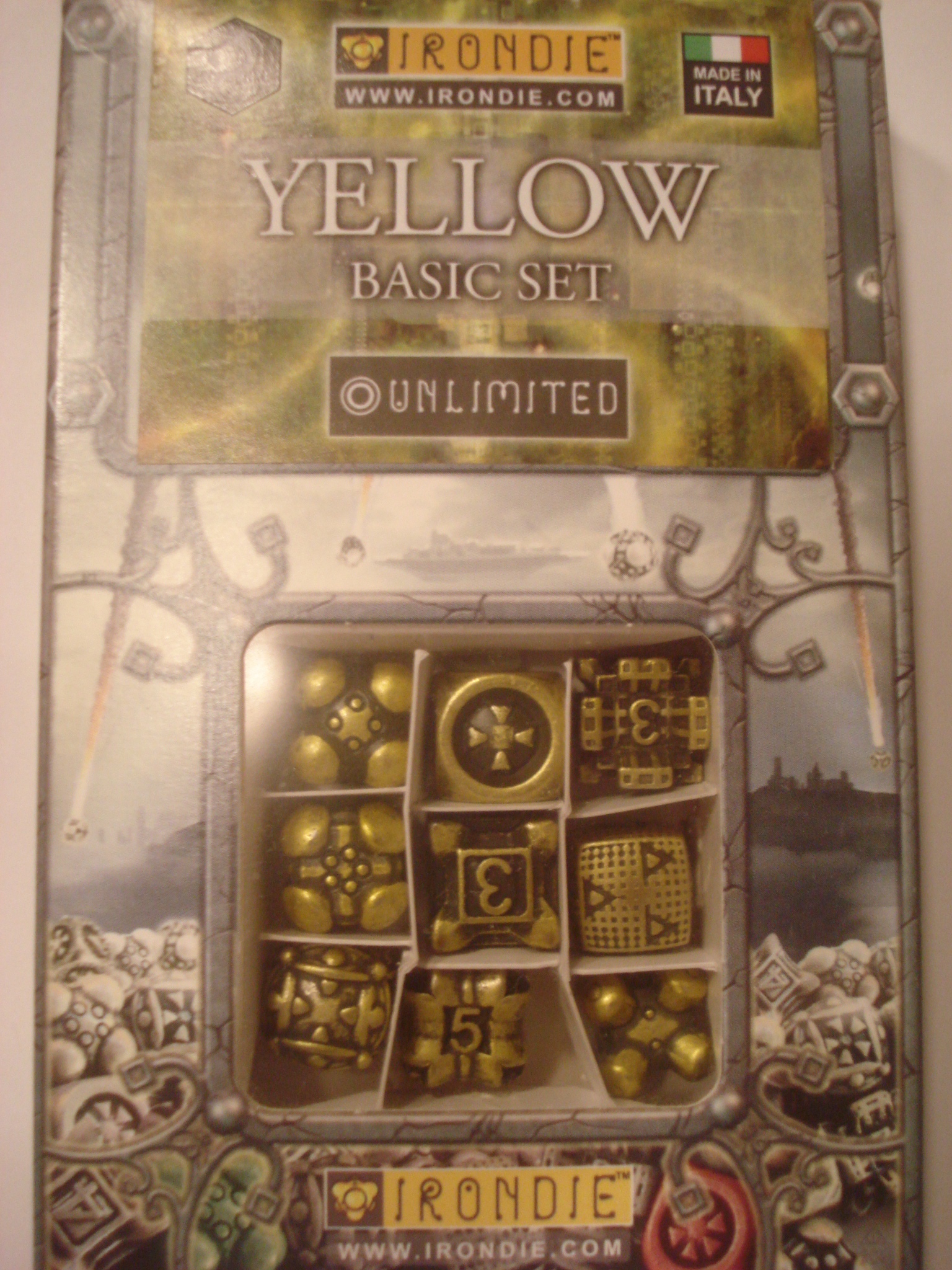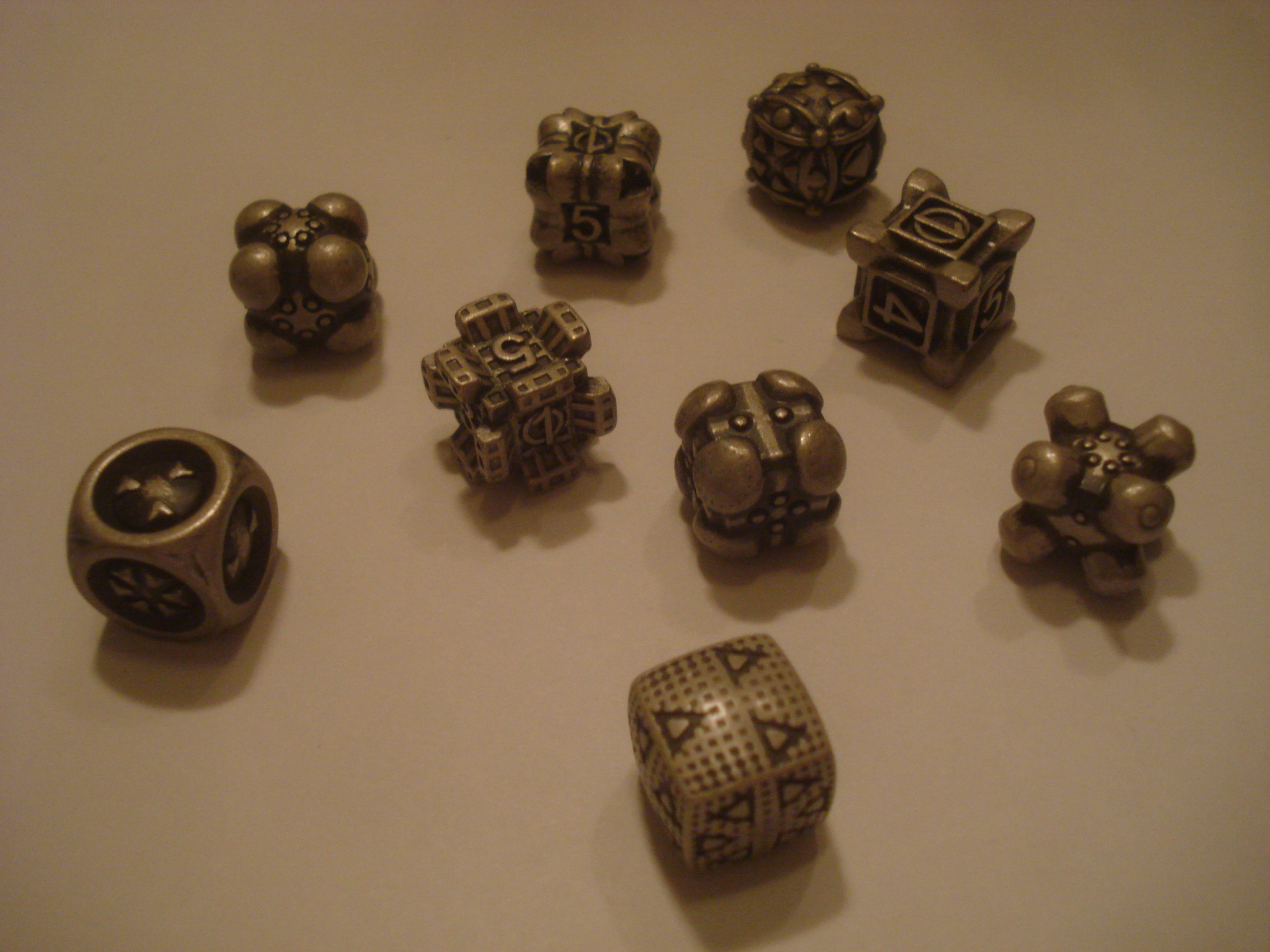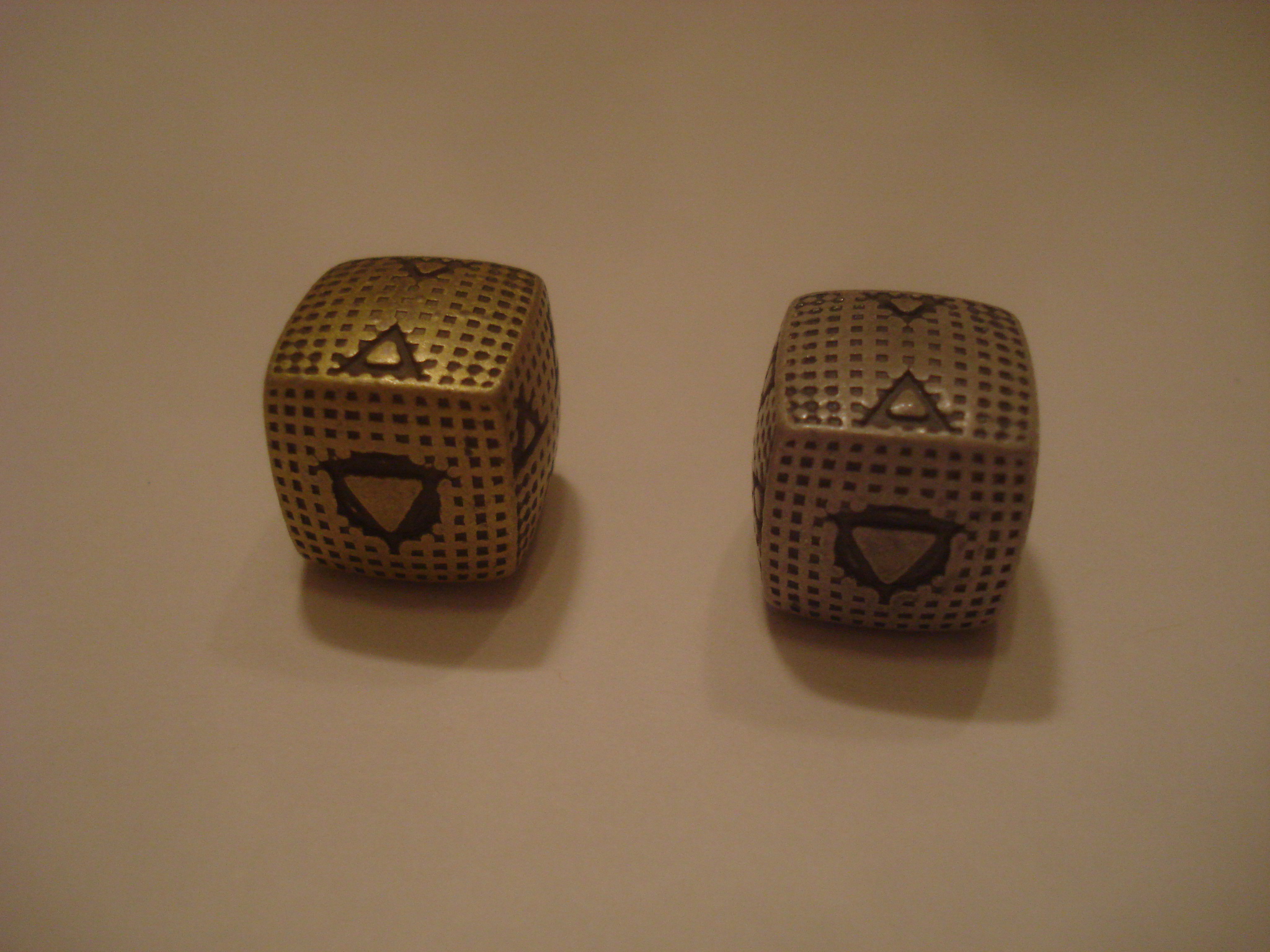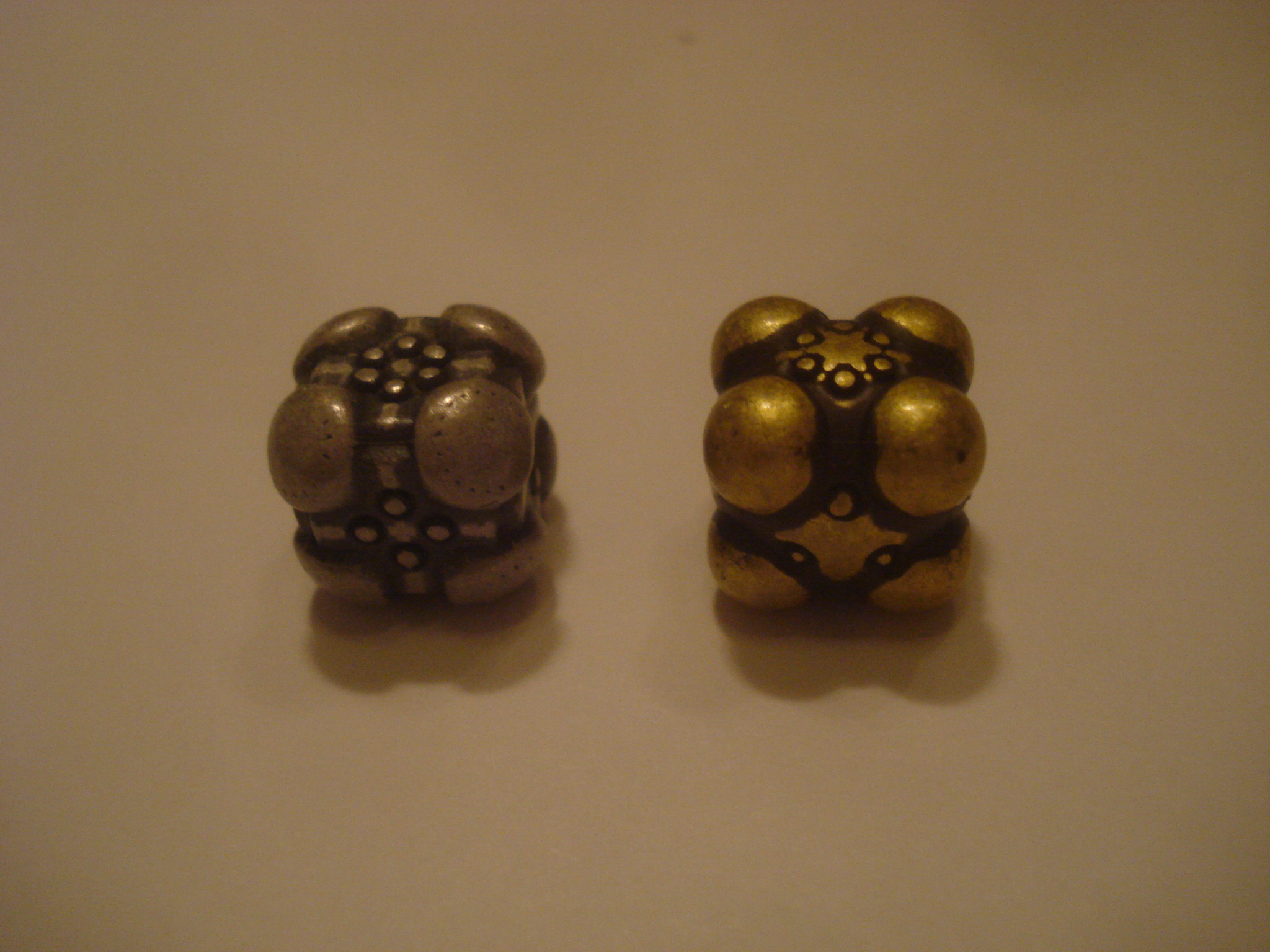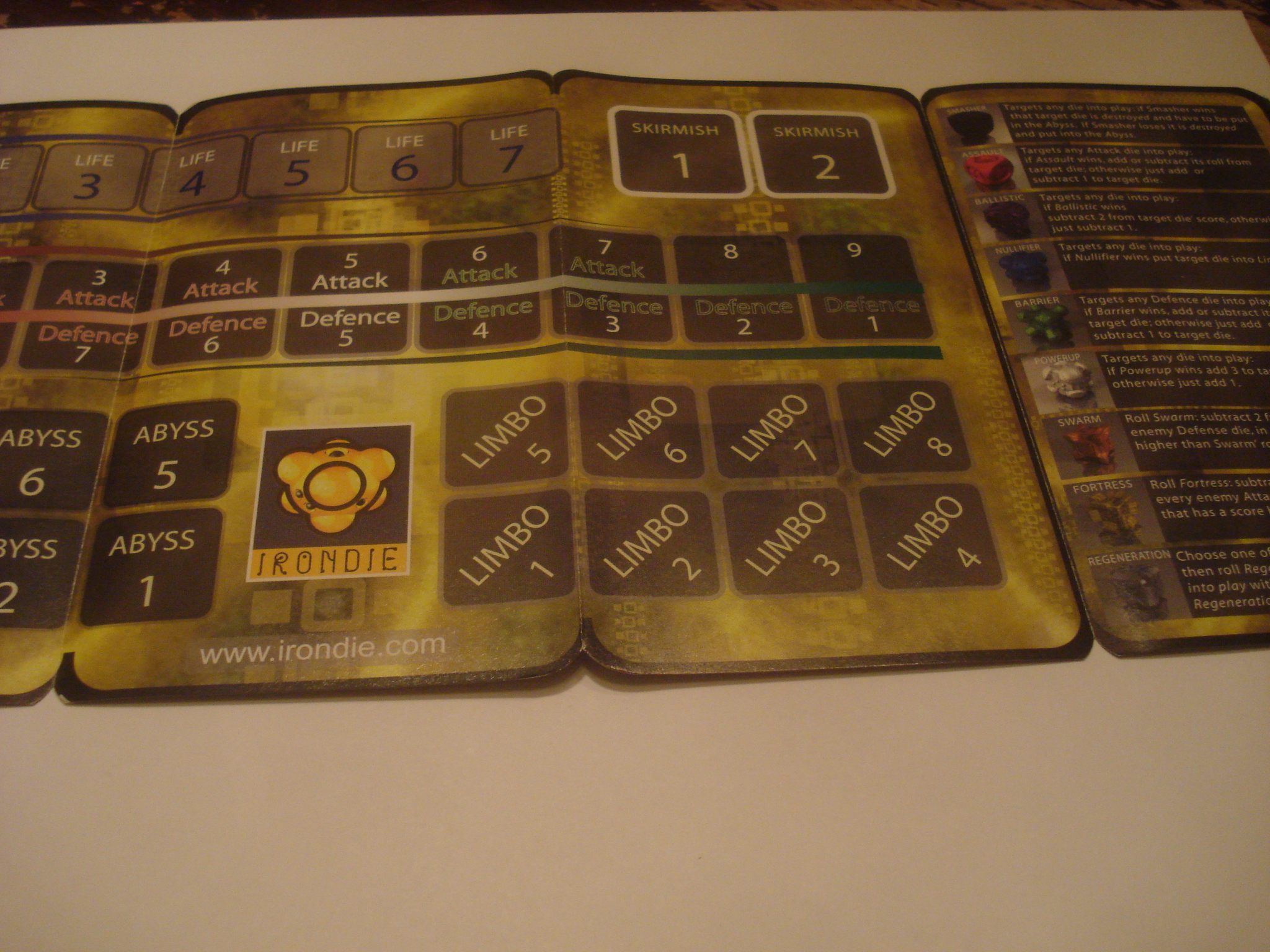| Publisher | Bluestar di Valtancoli Giulio and Green Lake Games |
| Game Contents | Nine dice, instructions, foldout playmat |
| Guidelines | Collectible dice and customizable dice game |
| MSRP | $54.99 (for the nine-dice Basic Set) |
| Reviewer | Andy Vetromile |
Dice. Your game table is lousy with them, so if a game company wants theirs to stand out, they know they’d better make it something special. That’s where Irondie comes in. Made of silver-plated white metal, dressed up in one of eight colors, custom-molded with different designs, and sold in sets of nine dice, they’re not just pretty, they’re also part of their own game. How does this stack up, both as an activity and a tool of the trade? An overview of play first.
The object of the game is to eliminate all the opponent’s Life dice.
Both players have a selection of nine six-sided dice, and these represent their ability to attack, defend, and stay alive. Opponents take up any number of dice from their “hand” and roll them simultaneously. You’re only in the game as long as you have one pip showing on one of your Life dice, so you need at least one of those to start. Throw as many as you like, but it’s a balancing act: Roll them all and you have no unused dice with which to respond to your opponent’s strategy, hold some back in the Reserve and his first assault may be enough to wipe you out. Attack dice beat on the enemy pieces while Defense protect other dice. A Basic Set has three of each kind, but these – and the various colors – can be mixed and matched to customize a set or “hand.” All of this keeps the game from being a straight-up dice comparison game.
Mind you, dice comparison is at the heart of the mechanics. The two players throw their dice: A player’s Defense total is subtracted from his opponent’s Attack total, and if there’s anything left over it gets through and does Damage to the Life dice. Sandwiched between the roll of the dice and the application of Damage, however, is a Skirmish phase. Here, any dice held in Reserve can be used for Duels – players alternate using special powers against each other in a chain of back-and-forth one-upmanship before the results are employed. Instead of straight Damage results, these dice use their special abilities to affect the game in other ways.
For example, one of the Attack dice is called a Smasher die; used in a Duel it zeroes in on any die already on the table. If it’s a higher roll it eliminates its target from the game before it has a chance to apply its effects (ties go to the defender). The Nullifier removes a die from play for one round, so the opponent could respond with that to negate the Smasher. Both players get to “reply” like this twice per Duel before applying the more simplified Attack-Defense-Life formula. Each color “specializes” in one of these dice, meaning it wins ties; every tone has its Smasher, but the black set’s Smasher can roll higher than or equal to. Colors are also characterized as Allied, Hostile, or Neutral to each other, according to a color-wheel chart, and Allies get even more bonuses from friendly dice that come up 1. For example, if one of your purple dice rolls a 1, it gives a +1 to an Attack and a Defense die – but only if those dice are red or blue. The strategy of “hand” construction is important even before the game begins, and smaller “boosters” are available that provide special rare dice with increased abilities.
If no one has succumbed to the loss of their Life, they go another round. Dice end up in Limbo when used, or the Abyss if destroyed; the former are renewed for the next round while the latter are out for the duration of the game. Players can reroll surviving Life dice in hopes of improving their numbers, but they must leave at least one on the table at all times. If ever someone has no Life they’re eliminated and their opponent wins, though results are applied simultaneously and leave open the possibility of a draw.
Blue-Star freely admits these dice are not scientifically balanced or accurate; you’re not going to see them showing up on tables in Vegas any time soon. Irondie is more like an objet d’art, albeit one you can toy with without museum staff pitching a fit. These metal chunks are satisfying to hold in the hand, their weight adding to the tactile delight they provide. The unusual shapes are fun and the die faces are pretty easy to read.
Unfortunately the appearance of some of the dice is also the sticking point with this product. The biggest problem with the game function of Irondie is some of the dice are sometimes tough to tell apart without closer examination. Mostly this is an issue with the Defense class of dice, and the yellow and white hues look an awful lot like each other. Others are no trouble to spot, but players are easily taken out of the flow of the game if they have to stop and squint at the diagrams the company provides (even if you can tell one die from another, you still need to know which one is which on the chart).
The game also provides a foldout playmat for one player. It’s printed with spaces for all the dice: not just the ones for Battle but also those used in Skirmishes, the ones that get sent to the Abyss, and so on. Players should have little trouble remember where they’ve committed their units, but it’s still a good organizational tool to keep everything straight with minimal fuss. The Chromatic Table (with all the special color bonuses on it) is on the opposite side where you won’t be able to get at it, but all this and more is easily downloaded from the website, including a more descriptive rulebook. The one included with the game is pretty good, insofar as it splits up the order of play and introduces concepts in a more digestible fashion. That’s a skill not all rulebooks have mastered, and should take note of.
Irondie is quite a bit to take in with each die providing so much information and all the rules to differentiate effects. These layered rules lend themselves well to strategy, though, offering enough ways to win that players who show a little interest may soon have a lot. A pack is pretty costly – $55 for a full set – but some stores have been breaking up boxes so players can buy in smaller, less expensive increments and customize their selection with a focus that collectible card games with their expansive, finely parsed rules can only envy. The company has plans for other “denominations” of dice outside the six-siders, though it’s not clear whether this represents a supplemental set of rules and options or if they’re meant to form a new game by themselves. And of course, even if you never play the game you’ve got one of the sweetest-looking collections at the table. Blue-Star has their market for Irondie figured out even if the consumers haven’t finished sussing out all the schemes available to them, both as collectors and players.
